History shows that some cars are a better long-term investment than others. There are plenty of people who have bought a car and squirreled it away in the belief that it will appreciate with each passing year. Some get it right, while others will get it catastrophically wrong. That brings us to the 1993 Cadillac Allante. Introduced as a performance luxury convertible to compete with the likes of Mercedes-Benz, a new example would have cost its owner a touch under $60,000. This is one of those cars, but you could own it today for a mere $11,900. It is located in Lakewood, Colorado, and has been listed for sale here on craigslist.
The owner claims that this Allante is 1-of-88 that Cadillac finished in Polo Green. I haven’t been able to confirm this figure, but it is certainly possible. The paint shines beautifully, with no signs of any significant scratches or marks. The panels are straight and clean, with no visible dings or dents. The soft-top and glass are in excellent order, while the wheels show no evidence of damage or issues. The construction of the Allante was an interesting one and involved what could loosely be termed as the world’s longest production line. The bodies were designed, built, and painted by Pininfarina at their factory in San Giorgio, Italy. The completed bodies were then loaded into special racks and shipped using Boeing 747s to the Cadillac plant in Hamtramck, Michigan, for final assembly. That represented a journey of 9,000 miles from the spot where the first weld was applied to the site where the Allantes rolled off the production line. That’s a pretty fair distance to cover before the car moved under its own power!
When you look at the Cadillac’s interior, there’s a lot to like and not much to criticize. It is upholstered in Cream leather, and apart from a few wrinkles, it looks supple and inviting. The carpet has avoided the wear and dirty appearance that can plague it when it is such a pale shade, while all of the plastic is in excellent order. This is a Cadillac, so luxury features abound. There is climate-control air conditioning, power windows, power locks, power seats, cruise control, a leather-wrapped wheel adjustable for tilt and reach, and a premium AM/FM radio and CD player.
When Cadillac conceived and designed the Allante, they were focused on enticing younger buyers to their brand. This was the logic behind building a 2-seat convertible and eventually providing it with some performance credentials to satisfy young professionals of that era. That is why we lift the hood and find the 4,565cc “Northstar” V8 that is pumping 295hp to the front wheels via a 4-speed automatic transmission. It might have weighed a reasonably portly 3,752lbs, but that little V8 could launch the Allante through the ¼ mile in 15.2 seconds before winding its way to a top speed of 152mph. The owner has recently had the emission completed and has replaced the plugs and wires. In his words, the Allante runs like a scared cat, which indicates that it has plenty of power and no problems to report.
The Allante wasn’t the sales success that Cadillac had hoped for, with the company choosing to drop the model after seven years in the market. The 1993 model year was the last, and it was also the most successful. Cadillac managed to sell 4,670 examples, which marked an incredible 33% increase over its previous best year. These cars have been largely unloved in the classic market, but that situation seems set to change. Values have begun to climb consistently over the past twelve months, and this doesn’t show any signs of easing. At $60,000, the Allante was a money-pit when it was new. However, at $11,900, it could represent a pretty reasonable investment. It’s a point to ponder.
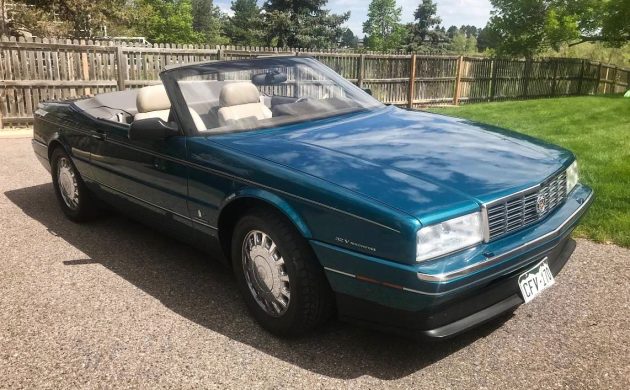
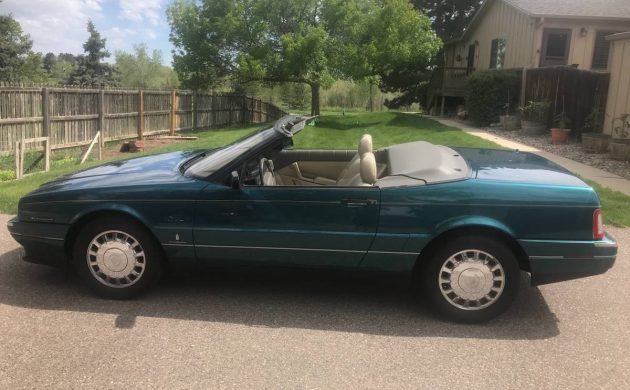
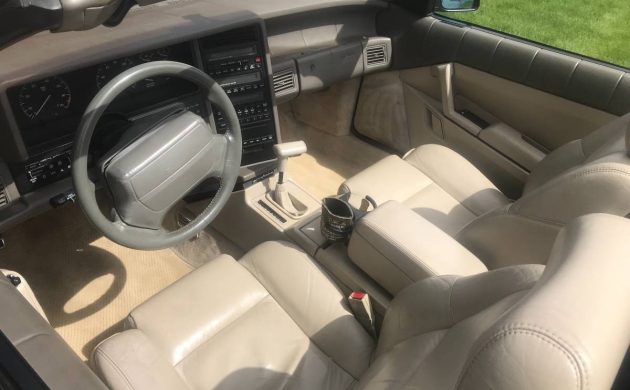
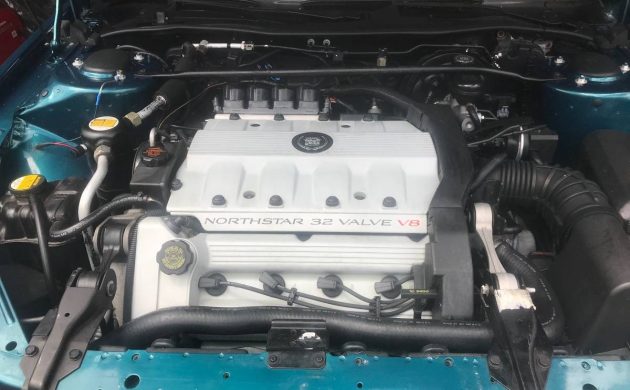
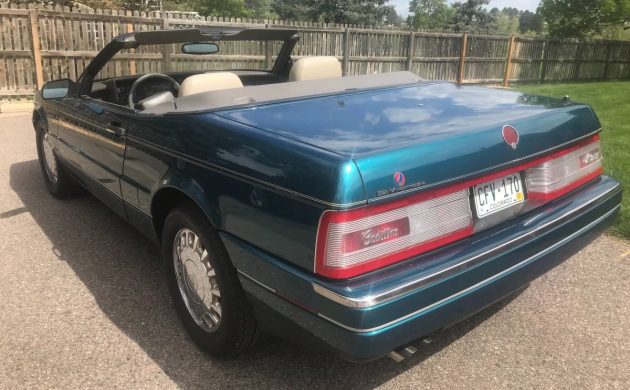


Like the car ,but in not this color.
It might seem heavy but consider that the new Mini Countryman weight about 200lbs more.
Not my type of car but they are nice to ride in and have known issues to check out. What other hobby car can you get for the price of a five year old corolla that is as nice to go down the road in? My preference would be to have a TR3. Imagine the price of a TR3 in this condition?
As I remember it, Yuppies (20-34 yrs old) bought mostly Beemers back then. Cadillacs were for the senior crowd. I think Cadillac was going for the 40-55 yr old market with the new Euro styled Seville and the Allante
How could Cadillac ever imagine a reasonably informed driving pubic would ever buy into a Front Wheel Drive performance car? If somebody wanted to give me one I’d respectfully decline the offer thankyou.
I don’t think that in 1986, front wheel drive was the curse word that it is today
This car was never intended to go to the race track, but it handles flat with remarkably direct stealing with excellent feel
Front wheel drives allowed a cavernous trunk, capable of taking two people and everything they could possibly desire on a ski vacation, scuba expedition, or somewhere they would need a lot of fancy clothes.
These cars were designed for that use and not for auto crossing.
And don’t forget that Saab, Audi, Lancia and other luxury:sports car builders were using front wheel drive at the time
I would be concerned about the odometer alignment…
Hate to tell them but there were 960 Polo Green ’93s built…858 with the beige interior…if 1 of 88 was going to influence your bid.
That is not “Polo Green.” I believe the correct name for it is “blue green metallic”
It has a Northstar..It was a money pit 30 years ago…It is still a money pit..
Polo Green was the second most popular color in the 1993 model year, behind Pearl Red. I’ve owned two of them. The 1-of-88 claim is complete BS. There were 960 Polo Green cars made in the extended 1993 model year, out of 4,670 total production.
That looks like blue green metallic and not polo green, to me
Color reproduction on a monitor can vary dramatically. Teal Green Metallic was also available for the 1993 model year. There were 150 of those cars produced. Without seeing the actual paint code on the car, or seeing the car in person, it’s impossible to know for sure. In some of the CL photos the car looks like Polo Green, in others it does not. Still not 1-of-88.
Agree with Joe, bought what I thought was cherry sedan de ville (80K, clean clean clean) for what I thought to be a great price until the Northstar starting having oil leak issues, detailed the crap out of it and traded it for a Toyota, they gave me pretty good money for it, but it broke my heart the Caddy was such a fine ride
There were 88 Pearl Flax cars made for the 1993 model year.
And THAT is a beautiful and rare color!
When they ran properly, they were a great car, but when the problems started they were horrendous, not to mention insanely expensive. I owned one for a short period.
I put a fair number of miles on mine. Wonderful car to drive, but a PITA to work on. The common GM parts were inexpensive, but the Allante-specific parts were unobtanium and priced accordingly. The 93 has a lot of one-year-only items also, like the outside mirrors, the little lip on the front air dam, etc.
I haven’t 87, and have all my vintage cars, it is actually the cheapest to maintain (I do not own any high end Italian cars or a Rolls-Royce!)
I have an ‘87 and it is a lovely car. Perfect for cruising around Fort Lauderdale or going on a weekend trip
Allantés have been dead in the water for a long time, but they are an excellent value for stylish transportation
Generally, the 93’s are seen as the most collectible, and this unusual color, which is “blue green metallic”, and not “polo green” is one of my favorites
The author makes a common mistake: The Allanté is not an all-aluminum automobile: its steel body and fenders were fabricated in Germany. The hood, trunk, and hard top we’re made of aluminum in Switzerland
I know of one person in this area who has a NorthStar Allanté with almost 600,000 miles… I think it’s on the second or third engine though
Nice set of wheels, but having owned a 1998 Cadillac STS with a Northstar V-8 that ended up with a GM known problem with a leaking split block seal at 75,000 miles which GM failed to stand behind the repair, followed up later with a leaking steering ram, (not covered by GM) and finally a heater core failure at 85,000 miles, sorry the warranted was long expired. The Northstar Split block seal problem was a killer $2,200.00 to fix. I understand in1999 or 2000, the GM engine guys corrected the split block seal problem on all new engines. My point is, if this Allante has anything close to 50,000 miles, the buyer needs to be careful, review the maintenance records, double check the recall history and warrantee work. The example here is a lovely car, the guys in Italy did a great job, GM here in America treated this car like any other production product.
I’m not kidding here:
As front wheel drive cars are apparently ideal for electric conversion, NorthStar a Allanté is an ideal candidate. Dump the engine, put in a Tesla drive train and drive trouble free!
I have a ’93, maybe the same color, looks black in some light, green (which it is) in other light. Transmission electronics have been the biggest problem, sometimes it shifts correctly, sometimes it does not. Previous owner replaced the transmission with a rebuilt, but problem persisted. Plastic radiator end split so had to be replaced, may have been a freeze up, but plastic was brittle. Radio/etc. quit, previous owner did an aftermarket unit in the trunk with a remote, used existing speakers, works fine. Bought an earlier hard top, some of the mechanism differs but it works, had it painted to match and it does
Northstar, so far, (145,000 miles) has been OK, it was peculiar in a few respects to the one used in the rest of the line since the hood was so low, and those parts are unobtainium, but my mechanic and I made one part out of enema hose and electrical tape which works fine.
It has a few dings, a missing piece of trim, the front air dam, which I guess is rare, is off the car, since it is so low it was getting scraped on my driveway, let alone other abrupt changes in road surface, and it is badly scratched up.
The leather seat has rippled, and the bolster is badly worn but it has 145,000 miles, there are plenty for museums, mine is a driver.
There are three sources for body/interior parts, some NOS, a very few reproductions (but with 3D printers I expect more in years to come – the issue being a color match) and lots of used parts off of junkers – they rusted or owners gave up on them.
The sources are in Florida, near Philly in New Jersey, and near San Diego. I have dealt with the NJ and SD guys and they are really helpful and good to deal with. Johnny Monzo in NJ and Tom Rohner in SD.
It has plenty of guts and no discernable torque steer and if the rear suspension is working it corners flat.
On the other hand, my wife will only ride in it, let alone drive it in emergencies, there is wind noise with the top down, top up, or hard top on and since we can’t leave our little community without going on an interstate type highway, that is an issue. It is a worthwhile trade off for me to be able to drive with the top down. I drive it a few times a week except in the winter (it snows here) when it sits with the trickle charger on, and ventures out into the driveway and idles for a while once a week or so.
Yes, the fenders are steel – mine has a rust bubble over one of the rear wheels, and little dents in the hood and trunk lid, to show that they are aluminum and soft.
I like the look of these, but that is about it.
And to be fair, my son bought a ’94 sedan which was a magnificent car for about 4 months, great in snow, great on the highway, but paid only $1300 for it, and then it died. HS student in his math class repaired it, deal was my son would pay for the parts, which were electronics, they would split the net proceeds, he got about $500 out of the deal so it was not a total loss.
The more electronic parts a car has, the less likely it can be fixed. Friend’s ’18 Chrysler corp van is waiting 3 weeks for a computer, probably so many have failed that the parts bin is empty. Happened to my ’84 Dodge Caravan when it was only 6 months old, the day before a family vacation. No parts at the depot, salesman offered to lend me his Chevy wagon, and called the parts dept at several dealers and located one for me, drove 35 miles to get it and pressured the service dept to install it. Bought two more cars from him in thanks.
I’ll just throw my 2 cents in here on Allantes. The text says at $60,000 they were money pits when new. Well, they’re still money pits. I owned a 17k mile, mint, beautiful example of a ’91 from 2012-18. Granted, ’91s didn’t have the Northstar but as time went on, I realized that was a blessing.
I hadn’t even driven the car 25 miles before the ABS pump gave out on me. Immediately, I was paying out $800 for an NOS Bosch pump for it and another $200 for labor to replace it, bleed the brake system and refill with fresh fluid. And so it went during my 6-year tenure with that car. There was always something going wrong and everything that did was so EXPENSIVE!
I dealt with the Allante expert and specialist in West Palm Beach, Florida. I mentioned to him one day that I really wondered why I was having so much trouble with a car that had only 17k miles. He responded by saying that low mileage was the kiss of death for those cars. They have so many electronics and he said those go bad from not being used. I sure wish I had talked to him before I bought that car.
Let me just say that it got so bad that I was afraid to drive the car anymore for fear that something else would go wrong with it. And that is not a fun feeling, I promise.
I’ll sum up by saying; no more, never again.
93s had a different ABS that fixed the problems of the prior cars. Those Teves systems needed to have the brake fluid flushed annually to prevent problems. Most people didn’t follow the service recommendations, and naturally blame the car.
My first 93 met an untimely death in an accident. The second one was retired at 150K miles when the electronics started having issues. It was nothing that couldn’t be fixed, I just got tired and didn’t want to mess with it any more. I do all my own work. The self diagnostic capabilities of the DIC on those cars was great for finding and fixing problems. The 93s fixed a lot of the issues on the earlier cars, like doing away with the overly complex multiplexed lighting system. I never had one bit of trouble with the N*, despite all the horror stories. No leaks, no issues. The biggest trouble I had with it was a leaking water pump. Cost me a whole $20 for the special tool.
The ’87-92 cars have a Bosch antilock brake system. I wish it were Teves, just for parts availability.
“I saw a Deadhead sticker on a a Cadillac”
Y’all just hum the rest of the song.